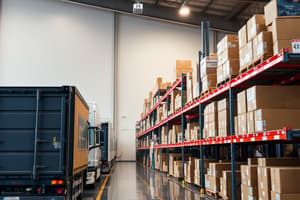Podcast
Questions and Answers
What is a critical factor when balancing customer service and costs in logistics?
What is a critical factor when balancing customer service and costs in logistics?
- Minimizing transportation costs without regard to service
- Finding a balance between warehousing and inventory costs (correct)
- Eliminating inventory to reduce costs
- Maximizing the number of warehouses only
How does an increase in the number of warehouses typically affect logistics costs?
How does an increase in the number of warehouses typically affect logistics costs?
- It can increase overall logistics costs but may enhance customer service. (correct)
- It leads to higher inventory costs only.
- It has no effect on warehousing costs.
- It always increases transportation costs significantly.
What tradeoff must be considered regarding facility-level resources?
What tradeoff must be considered regarding facility-level resources?
- Balancing space, equipment, and personnel affects performance. (correct)
- There is no tradeoff when balancing financial resources.
- Increasing personnel is always beneficial regardless of space.
- Space must be maximized at the expense of equipment.
What is a consequence of poor balance between warehousing and customer service?
What is a consequence of poor balance between warehousing and customer service?
What impacts the need for more equipment in distribution operations?
What impacts the need for more equipment in distribution operations?
How does warehousing cost relate to the number of warehouses?
How does warehousing cost relate to the number of warehouses?
Which of the following reflects a poor logistics strategy?
Which of the following reflects a poor logistics strategy?
What should be done to optimize both space and equipment in a facility?
What should be done to optimize both space and equipment in a facility?
Which of the following is NOT a direct consideration in logistics cost tradeoffs?
Which of the following is NOT a direct consideration in logistics cost tradeoffs?
In assessing logistics strategy, what primary element is considered alongside the number of warehouses?
In assessing logistics strategy, what primary element is considered alongside the number of warehouses?
What effect does the size of the workforce have on a facility's throughput?
What effect does the size of the workforce have on a facility's throughput?
Which of the following is a key challenge related to demand variation in distribution?
Which of the following is a key challenge related to demand variation in distribution?
What is a potential solution to the challenge of labor availability due to workforce turnover?
What is a potential solution to the challenge of labor availability due to workforce turnover?
In response to increasing customer requirements, what fulfillment strategy is most effective?
In response to increasing customer requirements, what fulfillment strategy is most effective?
How does the aging demographic trend impact the labor pool in distribution centers?
How does the aging demographic trend impact the labor pool in distribution centers?
What is the relationship between automation and labor requirements in distribution?
What is the relationship between automation and labor requirements in distribution?
Which of the following strategies addresses seasonal demand challenges?
Which of the following strategies addresses seasonal demand challenges?
What does the term 'throughput' refer to in the context of distribution centers?
What does the term 'throughput' refer to in the context of distribution centers?
What effect do lean strategies have on fulfillment processes?
What effect do lean strategies have on fulfillment processes?
Which factor primarily exacerbates labor availability issues in distribution centers?
Which factor primarily exacerbates labor availability issues in distribution centers?
Flashcards are hidden until you start studying
Study Notes
Key Distribution Tradeoffs
- Functional Tradeoffs focus on balancing customer service and costs, specifically around transportation, warehousing, and inventory.
- Transportation vs. Warehousing involves understanding the tradeoff between the cost of transportation and the cost of warehousing.
- Increasing the number of warehouses reduces transportation costs but increases warehousing costs.
- Tradeoffs are evident in the relationship between logistics costs, transportation costs, warehousing costs, and number of warehouses.
- Warehousing vs. Inventory considers the balance between warehouse costs and inventory costs.
- A higher number of warehouses leads to lower inventory costs but increases warehousing costs.
- Optimizing logistics costs involves understanding the relationship between these factors.
- Warehousing vs. Customer Service emphasizes the link between warehousing costs and customer service.
- Having more warehouses results in faster delivery times, leading to better customer service, but also increases warehousing costs.
- The cost of lost sales due to slow delivery times is a crucial consideration.
- Transportation vs. Warehousing involves understanding the tradeoff between the cost of transportation and the cost of warehousing.
Facility-Level Tradeoffs
- Space vs. Equipment: Larger facilities require more space, leading to higher equipment needs. Increased space utilization results in more equipment required for effective operations.
- Equipment vs. People vs. Space: Efficient facility operations involve balancing the use of equipment, personnel, and space to optimize throughput.
- Utilizing equipment for automation can reduce the labor needs of a facility.
- Larger facilities can accommodate more equipment and higher throughput, but require a larger workforce.
Key Challenges in Distribution
- Labor Availability: Distribution centers face ongoing challenges with labor availability.
- Demand Variation: Seasonal demand creates challenges in effectively utilizing space and equipment and maintaining a stable workforce throughout the year.
- Solutions involve balancing seasonal products with products having alternate selling seasons or stable year-round demand.
- Demand Variation: Seasonal demand creates challenges in effectively utilizing space and equipment and maintaining a stable workforce throughout the year.
- Increasing Customer Requirements: The increasing need for additional capabilities and services poses challenges for distribution centers.
- Lean Strategies: Consumers expect smaller, more frequent, and faster order fulfillment.
- Solutions involve adapting to flexible fulfillment processes.
- Lean Strategies: Consumers expect smaller, more frequent, and faster order fulfillment.
- Labor Availability Issues: The nature of distribution center operations leads to high turnover rates.
- Aging Demographics: Smaller labor pool due to aging trends in developed regions.
- Solutions involve using automation to address labor shortages.
- Aging Demographics: Smaller labor pool due to aging trends in developed regions.
Studying That Suits You
Use AI to generate personalized quizzes and flashcards to suit your learning preferences.




